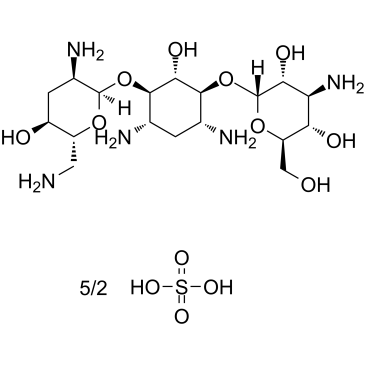49842-07-1
| Name | (2S,3R,4S,5S,6R)-4-amino-2-[(1S,2S,3R,4S,6R)-4,6-diamino-3-[(2R,3R,5S,6R)-3-amino-6-(aminomethyl)-5-hydroxyoxan-2-yl]oxy-2-hydroxycyclohexyl]oxy-6-(hydroxymethyl)oxane-3,5-diol,sulfuric acid |
|---|---|
| Synonyms |
Tobra
1-(3,4-Dimethoxyphenyl)-5-ethyl-7,8-dimethoxy-4-methyl-5H-2,3-benzodiazepine 1-(3,4-dimethoxy-phenyl)-4-methyl-5-ethyl-7,8-dimethoxy-5H-2,3-benzodiazepine (2S,3R,4S,5S,6R)-4-amino-2-{[(1S,2S,3R,4S,6R)-4,6-diamino-3-{[(2R,3R,5S,6R)-3-amino-6-(aminométhyl)-5-hydroxytétrahydro-2H-pyran-2-yl]oxy}-2-hydroxycyclohexyl]oxy}-6-(hydroxyméthyl)tétrahydro-2H-pyran (2S,3R,4S,5S,6R)-4-amino-2-{[(1S,2S,3R,4S,6R)-4,6-diamino-3-{[(2R,3R,5S,6R)-3-amino-6-(aminomethyl)-5-hydroxytetrahydro-2H-pyran-2-yl]oxy}-2-hydroxycyclohexyl]oxy}-6-(hydroxymethyl)tetrahydro-2H-pyran-3,5-diol sulfate (salt) 1-Epitobramycin sulfate Tobra Gobens Tomycin EINECS 256-499-2 5H-2,3-Benzodiazepine, 1-(3,4-dimethoxyphenyl)-5-ethyl-7,8-dimethoxy-4-methyl- 5-aethyl-1-(3,4-dimethoxyphenyl)-7,8-dimethoxy-4-methyl-5H-benzodiazepin (1S,2S,3R,4S,6R)-4,6-Diamino-3-[(2,6-diamino-2,3,6-trideoxy-α-D-ribo-hexopyranosyl)oxy]-2-hydroxycyclohexyl 3-amino-3-deoxy-α-D-glucopyranoside sulfate (salt) Dicon Egyt 341 Obracine EINECS 244-922-3 (1S,2S,3R,4S,6R)-4,6-Diamino-3-[(2,6-diamino-2,3,6-trideoxy-α-D-ribo-hexopyranosyl)oxy]-2-hydroxycyclohexyl 3-amino-3-deoxy-α-D-glucopyranoside sulfate (1:1) Dartobcin Tofisopamum [INN-Latin] Nebicina Tobracin Tofisopam [INN:DCF:JAN] Emandaxin Nebcine UNII:UZC80HAU42 Gernebcin Obracin Tobraneg Tobramycin sulphate 7,8-dimethoxy-1-(3,4-dimethoxyphenyl)-5-ethyl-4-methyl-5H-2,3-benzodiazepine -3,5-diol sulfate (salt) -3,5-diolsulfat(salt) (2S,3R,4S,5S,6R)-4-amino-2-{[(1S,2S,3R,4S,6R)-4,6-diamino-3-{[(2R,3R,5S,6R)-3-amino-6-(aminométhyl)-5-hydroxytétrahydro-2H-pyran-2-yl]oxy}-2-hydroxycyclohexyl]oxy}-6-(hydroxyméthyl)tétrahydro-2H-pyran-3,5-diol sulfate (salt) Tenemicin Tobrasix Grandaxin 1-[3,4-bis(methyloxy)phenyl]-5-ethyl-4-methyl-7,8-bis(methyloxy)-5H-2,3-benzodiazepine Tofisopam Nebcin 1-(3,4-dimethoxyphenyl)-7,8-dimethoxy-5-ethyl-4-methyl-5H-2,3-benzodiazepine α-D-Glucopyranoside, (1S,2S,3R,4S,6R)-4,6-diamino-3-[(2,6-diamino-2,3,6-trideoxy-α-D-ribo-hexopyranosyl)oxy]-2-hydroxycyclohexyl 3-amino-3-deoxy-, sulfate (1:1) (salt) 7,8-Dimethoxy-1-(3,4-dimethoxyphenyl)-5-ethyl-4-methyl-5H-2,3-benzodiazepine,EGYT 341,Seriel Trazil tofizopam Tobryne (2S,3R,4S,5S,6R)-4-Amino-2-{[(1S,2S,3R,4S,6R)-4,6-diamino-3-{[(2R,3R,5S,6R)-3-amino-6-(aminomethyl)-5-hydroxytetrahydro-2H-pyran-2-yl]oxy}-2-hydroxycyclohexyl]oxy}-6-(hydroxymethyl)tetrahydro-2H-pyran Seriel (2S,3R,4S,5S,6R)-4-Amino-2-{[(1S,2S,3R,4S,6R)-4,6-diamino-3-{[(2R,3R,5S,6R)-3-amino-6-(aminomethyl)-5-hydroxytetrahydro-2H-pyran-2-yl]oxy}-2-hydroxycyclohexyl]oxy}-6-(hydroxymethyl)tetrahydro-2H-pyran-3,5-diolsulfat(salt) |
| Description | Tobramycin sulfate (Nebramycin Factor 6 sulfate) is a parenterally administered, broad spectrum aminoglycoside antibiotic that is widely used in the treatment of moderate to severe bacterial infections due to sensitive organisms[1]. |
|---|---|
| Related Catalog | |
| References |
[1]. Tobramycin. |
| Density | 1.52g/cm3 |
|---|---|
| Boiling Point | 775.4ºC at 760mmHg |
| Molecular Formula | C18H37N5O9.5/2H2O4S |
| Molecular Weight | 565.593 |
| Flash Point | 422.8ºC |
| Exact Mass | 565.226501 |
| PSA | 351.15000 |
| Storage condition | 2-8°C |
CHEMICAL IDENTIFICATION
HEALTH HAZARD DATAACUTE TOXICITY DATA
|
| Hazard Codes | T: Toxic; |
|---|---|
| Risk Phrases | R61 |
| Safety Phrases | 53-22-36/37/39-45 |
| WGK Germany | 3 |
